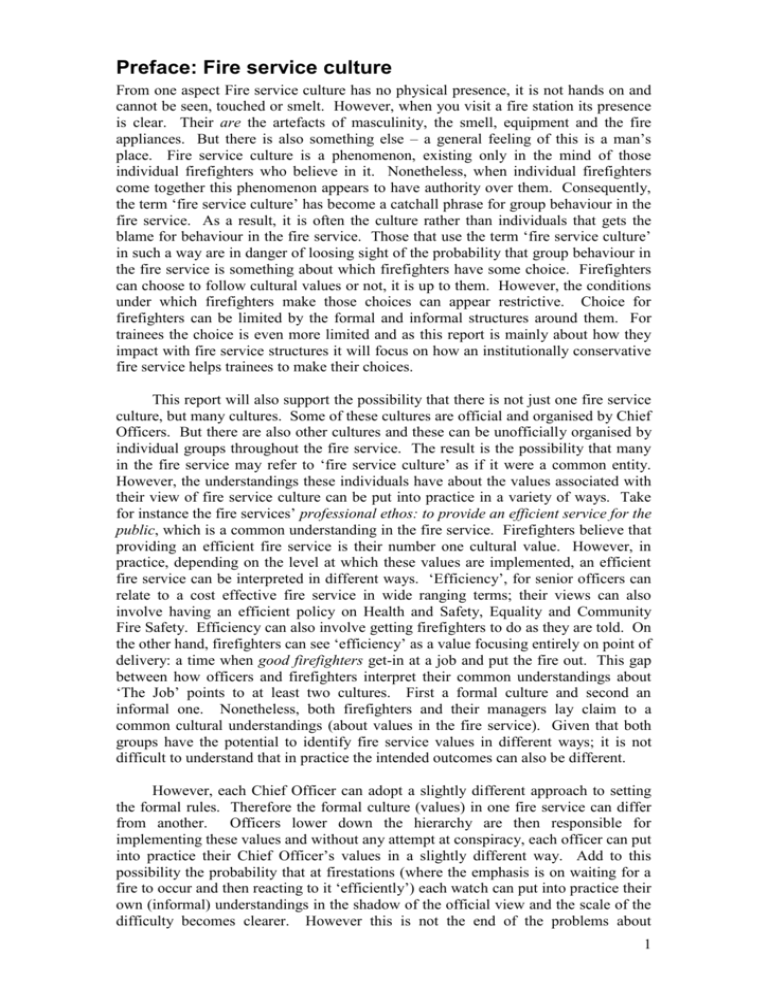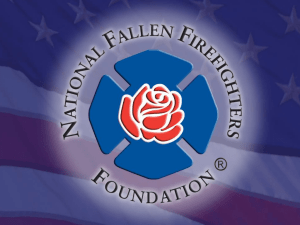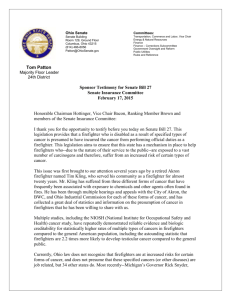Preface: Fire service culture - Fitting-In?
advertisement

Preface: Fire service culture From one aspect Fire service culture has no physical presence, it is not hands on and cannot be seen, touched or smelt. However, when you visit a fire station its presence is clear. Their are the artefacts of masculinity, the smell, equipment and the fire appliances. But there is also something else – a general feeling of this is a man’s place. Fire service culture is a phenomenon, existing only in the mind of those individual firefighters who believe in it. Nonetheless, when individual firefighters come together this phenomenon appears to have authority over them. Consequently, the term ‘fire service culture’ has become a catchall phrase for group behaviour in the fire service. As a result, it is often the culture rather than individuals that gets the blame for behaviour in the fire service. Those that use the term ‘fire service culture’ in such a way are in danger of loosing sight of the probability that group behaviour in the fire service is something about which firefighters have some choice. Firefighters can choose to follow cultural values or not, it is up to them. However, the conditions under which firefighters make those choices can appear restrictive. Choice for firefighters can be limited by the formal and informal structures around them. For trainees the choice is even more limited and as this report is mainly about how they impact with fire service structures it will focus on how an institutionally conservative fire service helps trainees to make their choices. This report will also support the possibility that there is not just one fire service culture, but many cultures. Some of these cultures are official and organised by Chief Officers. But there are also other cultures and these can be unofficially organised by individual groups throughout the fire service. The result is the possibility that many in the fire service may refer to ‘fire service culture’ as if it were a common entity. However, the understandings these individuals have about the values associated with their view of fire service culture can be put into practice in a variety of ways. Take for instance the fire services’ professional ethos: to provide an efficient service for the public, which is a common understanding in the fire service. Firefighters believe that providing an efficient fire service is their number one cultural value. However, in practice, depending on the level at which these values are implemented, an efficient fire service can be interpreted in different ways. ‘Efficiency’, for senior officers can relate to a cost effective fire service in wide ranging terms; their views can also involve having an efficient policy on Health and Safety, Equality and Community Fire Safety. Efficiency can also involve getting firefighters to do as they are told. On the other hand, firefighters can see ‘efficiency’ as a value focusing entirely on point of delivery: a time when good firefighters get-in at a job and put the fire out. This gap between how officers and firefighters interpret their common understandings about ‘The Job’ points to at least two cultures. First a formal culture and second an informal one. Nonetheless, both firefighters and their managers lay claim to a common cultural understandings (about values in the fire service). Given that both groups have the potential to identify fire service values in different ways; it is not difficult to understand that in practice the intended outcomes can also be different. However, each Chief Officer can adopt a slightly different approach to setting the formal rules. Therefore the formal culture (values) in one fire service can differ from another. Officers lower down the hierarchy are then responsible for implementing these values and without any attempt at conspiracy, each officer can put into practice their Chief Officer’s values in a slightly different way. Add to this possibility the probability that at firestations (where the emphasis is on waiting for a fire to occur and then reacting to it ‘efficiently’) each watch can put into practice their own (informal) understandings in the shadow of the official view and the scale of the difficulty becomes clearer. However this is not the end of the problems about 1 understanding fire service culture. As an example, tradition in the fire service points to the possibility that all firefighters seek to achieve the label good firefighter. And this is certainly true of those trainees that I have interviewed. However, again, at watch level, there are many interpretations of the attributes of a ‘good firefighter’. Some watches can believe that their speed at getting-in to put the fire out is important. Other watches may choose more reasoned approaches to firefighting, whereby a good firefighter is someone who takes a slightly slower approach to getting-in involving an increased emphasis on dynamic risk assessment. For others, good firefighters may require different attributes relating to agendas that appear to have nothing to do with firefighting. In this respect, some in the fire service question the ability of black, female or gay firefighters to do The Job. These types of prejudices can extend to the ludicrous point where watch members may consider that their black firefighter can meet their standards, but this will not stop them from believing that all other black people are unlikely to meet their standards for becoming good firefighters. Therefore, it is possible to argue that whenever a group of firefighters get together to discuss their work (in particular when they stay together for a long time) that they will form a fire service culture. The real difficulty is that like officers they believe that their fire service culture is the fire service culture. The subsequent (mis)use of the word culture as if it had one meaning, can then lead to difficulties for those trying to improve the fire service. Such a complicated situation is made harder because each group thinks that their values are common, right and natural. The result being that anyone who tries to change one group’s view of their culture is seen as a traitor to common values. Following this research, it is clear that one area having difficulty with fire service culture is the training centre. Chief Officers can make clear their wish for trainee firefighters to gain particular skills and to adopt new agendas. However, it is possible for instructors to marginalise some agendas and replace them with others that they believe are right for The(ir) Job. This unofficial interpretation of a Chief Officer’s intentions can result in instructors arguing that they know best the type of firefighter that the station expects. The outcome is that instructors fit trainees in with a model not entirely chosen by their Chief Officer and one that also includes their (innocently) accepting the informal agendas firefighters on the station expect. Differences between the legitimate requirements of senior managers and the outcome at point of delivery are increasingly causing concern in a fire service. Chief Officers seeking to comply with government’s efficiency agendas are not always successful. In particular, recruitment targets for ethnic minorities and women are not being met. On many watches the concept of equality and diversity (fairness for all) is not something that sits easily within a predominantly white, working class, heterosexual, male fire service. As suggested earlier, attempts to improve the representation of women and minority ethnic groups has led to different opinions about who can and cannot achieve the standards for a good firefighter. Firefighters are also uncomfortable with the Government’s agenda for firefighters to become more active in the community to prevent fires before they start. To an extent, both of these new agendas are linked because they challenge the view by many firefighters that their job (and identity) is about proving yourself in the action side of The Job; little to do with equality or community fire safety. The structure of the fire service in itself legislates against change. There are over 3000 watches in the UK fire service. Each watch bonds very closely around a peer group led hierarchy that defines watch culture i.e. the nature of their work, the attributes of a good firefighter and the level of resistance to their senior officers. Given that each watch hierarchy forms up on a time served basis and that firefighters can serve on the same watch for up to 30 years, the power these hierarchies can wield 2 is considerable. Largely, firefighters are not aware of their different approaches to The Job. The(ir) Job as they see it is a shared value that they would define under the all embracing term ‘fire service culture’. But, to emphasise an earlier view, this is not the case. There is not just one fire service culture. Nor, when you include the unofficial fire service culture are their just two cultures. In the fire service, the potential exists to have a different culture on each watch. Each of these cultures has no physical presence; it is in effect the combined view of a bonded group forming up in a hierarchy under one or two peer group leaders. However, irrespective of the differing interpretations firefighters have for fire service culture, where it is defined and the fact that fire service cultures exist only because people are persuaded to join them, nothing yet in the fire service has been successful in diverting the authority that individuals and the groups they form give to their fire service culture. Looking at trainees as they leave the training centre it appears that they have natural attributes that allow them to bond together. Yet this bonded group will divide and in turn fit-in with the cultural beliefs of the watch they are posted to. However, that which appears natural is not natural at all. These trainees have been taught a set of values by their instructors, which they recognise as fire service culture. And their practical skills apart, foremost amongst the values these trainees have been taught is the need to fit-in. But instructors cannot take full credit for providing firefighters who will fit-in on the watch. As applicants, these trainees had to prove that they really wanted to be firefighters (in similar terms) to those who interview them. The fact that they have been able to do this suggests that they have drawn on their earlier experiences of group working. This experience will include the recognition that to join a group you may (in the short term) have to bend to the will of leaders (official or unofficial) rather than stand apart and be seen as different. In the longer term of course applicants recognise that they will gain in influence in the group and in turn enjoy the power it wields. Instructors may “groom” trainees to act as someone that instructors would be “willing to go out there and ride on the back of fire appliances with.” However, they are more able to do this because of the type of person the fire service employs. Trainees therefore leave the training centre with a considerable belief that they must fit-in with the views of the watch they are about to join. This then makes them vulnerable to peer group leaders, who have no official power in the organisation, but are able to project their own agendas onto trainees (in similar fashion as the instructors did). This is not unexpected, because with so much emphasis on teamwork, firefighters are trained to act as teams and for the good of the team. Training has denied their ability to be individuals, except to point to differences that need to be corrected for the good of the team. Nor has training provided an ability to recognise the boundaries between official and unofficial policy. Newly prepared to fit-into the system, trainees do not recognise that often they can have a choice about what areas they must fit-in with and where they can legitimately stand apart. Having argued that culture has no power, except for an individual’s belief in its existence (and importance), is not to argue that some in the fire service are not aware of their ability to influence the culture within which they operate. In the case of Chief Officers, this represents legitimate authority. Chief Officers may for example persuade officers to support equal opportunities. Nevertheless, this does not mean that individually all the officers support equal opportunities. However, because senior officers loyalty is to the Chief Officer this takes precedence over their own beliefs. However, at some point in the hierarchy, loyalty to the Chief Officer and the ability to recognise if official policy is being followed diminishes. The training centre may be one example of where this happens. Instructors may implement the letter but not the 3 spirit of the equality message – “they treat everyone the same.” It is also possible that instructors will believe they know better than their Chief Officer does. Instructors can then set out to deliberately and covertly divert their Chief Officer’s instructions by offering alternative agendas in the shadow of official policy. The watch too can behave in a similar fashion. Despite the Chief Officer’s views on equality and the possibility that a majority of the watch are not sexist, a sexist peer leader may hold sufficient sway over the watch to uphold sexist agendas. Informal peer group leaders (or instructors) may lack legitimacy, but this is not so apparent when you are new in an organisation. This is a complicated matter but being complicated does not mean it is beyond understanding. Chief Officers, who wish to ensure that their values are implemented, may be more successful if they recognise the authority that peer group leaders wield. Rather than confronting such groups with rules and regulations that can only apply whilst they are being overseen, it may be better to influence informal authority at the point where values are put into practice. The aim should be to employ individuals who know when to fit-in and when not to and to ensure they retain this ability once they arrive at the station. To do this, Chief Officers will need to understand that their views are not law and that without winning hearts and minds the informal hierarchy will continue to influence the definition of The(ir) Job, the attributes of a good firefighter and how a fire service, station or watch is efficient. Such is fire service culture; it is based on a traditional belief in shared values, yet organised in an arena where formal and informal leaders vie for power to create a multitude of cultures. 4



